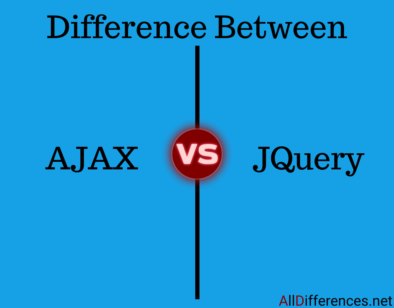Difference Between AJAX And JQuery
Contents
Comparison Between AJAX And JQuery in Tabular Form
The Key Difference Between AJAX And JQuery is that AJAX is a technique for creating fast and dynamic web pages, Whereas JQuery is a JavaScript library that simplifies common tasks like traversing the DOM, handling events, and making AJAX requests.
- JQuery is built on top of JavaScript, it is a library that makes it easy to use AJAX and other JavaScript functionality on websites.

Comparison Chart
- AJAX and jQuery both have different features and functionalities, here is a comparison of some key features between them.
| AJAX | JQuery |
|---|---|
| Asynchronous JavaScript and XML | JQuery |
| AJAX is designed to simplify Callbacks, Making Asynchronous Calls, User-Friendly, Increased Speed | jQuery is a JavaScript library designed to simplify the client-side scripting of HTML. |
| It works on the browser or outside the browser also. | It makes it easy to use AJAX in your project. |
| It only works on the client side. | It also works on the client side. |
AJAX:
- Asynchronous: AJAX allows web pages to update asynchronously, meaning that it can update content without having to refresh the entire page.
- XML and JSON Support: AJAX can work with both XML and JSON data formats.
- Cross-browser compatibility: AJAX is compatible with all major web browsers
- Complex coding: AJAX requires complex coding and knowledge of JavaScript and XML.
Features
- User Friendly
- It makes web page faster.
- Independent of server technology.
- Increase the Performance of the web page.
- Support for Live data binding
- Support for the Data View control
- Support for Client-side template rendering
- Rich and, responsive user interfaces
- Reduced consumption of server resources
JQuery:
- Cross-browser compatibility: jQuery is compatible with all major web browsers.
- Simplified coding: jQuery simplifies the process of using JavaScript, making it more accessible to developers with less experience.
- Event handling: jQuery makes it easy to handle events such as clicks, hovers, and more.
- DOM manipulation: jQuery provides a simple and consistent API for traversing and manipulating the Document Object Model (DOM).
- Animation and effects: jQuery provides a number of methods for creating animations and effects, such as fading and sliding elements.
- AJAX support: jQuery provides a simple API for making AJAX requests and working with the response data.
Features
- HTML/DOM manipulation.
- CSS manipulation.
- HTML event methods.
- Effects and animations.
- AJAX.
- Utilities.
